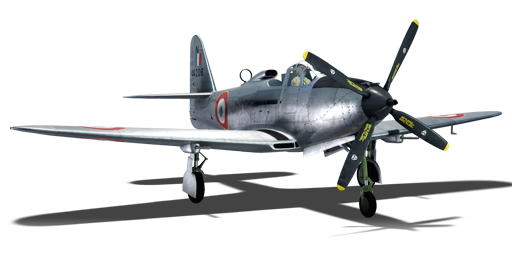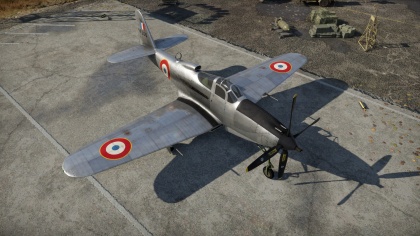P-63C-5 (France)
Contents
| This page is about the French fighter P-63C-5 (France). For other uses, see P-63 (Family). |
Description
The ▄P-63C-5 Kingcobra is a rank French fighter
with a battle rating of (AB), (RB), and (SB). It was introduced in Update 1.73 "Vive la France".
The aircraft is a high altitude interceptor/ energy fighter, with it's turn radius slightly better than before. The quick dive speed and high energy retention allows the player, with the correct altitude, to engage opponents below numerous times using the high yo-yo method. This aircraft should not be used for ground attacking due to it's average ammo count.
The 37 mm M10 cannon is ridiculously powerful. Aim carefully when firing, and do not fire too quickly, lest your gun jam and you lose your main weapon. A single shot to a wing or fuselage of an enemy plane will be all that it takes to bring it down.
The M2 Brownings are similar to the guns on the Bf-109 spotters. Use them to judge the range for your cannon shot. They are almost useless (except for those lucky pilot snipes) offensively.
General info
Flight performance
| Characteristics | Max Speed (km/h at 4,572 m) |
Max altitude (metres) |
Turn time (seconds) |
Rate of climb (metres/second) |
Take-off run (metres) | |||
|---|---|---|---|---|---|---|---|---|
| AB | RB | AB | RB | AB | RB | |||
| Stock | 627 | 609 | 24.2 | 25.1 | 16.8 | 16.8 | 289 | |
| Upgraded | 710 | 663 | 22.3 | 23.0 | 29.0 | 21.7 | ||
Details
| Features | ||||
|---|---|---|---|---|
| Combat flaps | Take-off flaps | Landing flaps | Air brakes | Arrestor gear |
| ✓ | ✓ | ✓ | X | X |
| Limits | ||||||
|---|---|---|---|---|---|---|
| Wings (km/h) | Gear (km/h) | Flaps (km/h) | Max Static G | |||
| Combat | Take-off | Landing | + | - | ||
| 390 | 390 | 260 | ~12 | ~6 | ||
| Optimal velocities (km/h) | |||
|---|---|---|---|
| Ailerons | Rudder | Elevators | Radiator |
| < 410 | < 380 | < 410 | > 320 |
Survivability and armour
- 38 mm Bulletproof glass in front of pilot.
- 12.7 mm Steel plate behind pilot's top body.
- 6.35 mm Steel plates on cockpit doors.
- 19.05 mm Steel plate behind 37 mm autocannon.
- 15.87 mm Steel plates in front of pilot's feet.
- 12.7 mm Steel plate behind engine.
Armaments
Offensive armament
The P-63C-5 (France) is armed with:
- 1 x 37 mm M10 cannon, nose-mounted (58 rpg)
- 2 x 12.7 mm M2 Browning machine guns, nose-mounted (250 rpg = 500 total)
- 2 x 12.7 mm M2 Browning machine guns, wing-mounted (200 rpg = 400 total)
Suspended armament
The P-63C-5 (France) can be outfitted with the following ordnance:
- Without load
- 3 x 500 lb AN-M64A1 bombs (1,500 lb total)
Usage in battles
This aircraft is an improved version of the P-63A-10 carrying the same armament and main gun. The aircraft is still a high altitude interceptor/energy fighter, with its turn radius slightly better than before. The quick dive speed and high energy retention allow the player, with the correct altitude, to engage opponents below numerous times using the high yo-yo method. This aircraft should not be used for ground attack due to its average ammo count.
The 37 mm M10 cannon is ridiculously powerful. Aim carefully when firing, and do not fire too quickly, lest your gun jam and you lose your main weapon. A single shot to a wing or fuselage of an enemy plane will be all that it takes to bring it down.
The role of the M2 Brownings are similar to the guns on the Bf-109 - spotters. Use them to judge the range for your cannon shot. They can also be used to try for a lucky engine fire or pilot snipe in a pinch.
Unfortunately, the C-5 is relatively superior to its predecessors. It has far more cannon ammo and a slightly lower climb rate than the A-10. However, this is relatively trivial as both planes are generally evenly matched. Keep this in mind, though, when selecting your load out of planes.
It is recommended to use the P-63 against large fighters and bombers. It is far easier to hit a bomber with the cannon then a small fighter with it.
Head-on attacks are not advisable- the large cannon combined with the relatively weak M2s make for poor head on accuracy. Only engage in head-ons if you are absolutely confident in your aim.
Boom & Zoom is also an effective tactic with this plane. Its large cannon makes getting shots while diving relatively easy, and its high climb rate and energy retention can get it to safety.
Bomber hunting is also extremely effective with the P-63, a large bomber is far easier to hit with a massive cannon. A single shot can take off a bomber's wing. However, don't spam the cannon. Keep the delay between shots at 1-1.5 second. Firing too quickly will result in a jam, which makes your plane almost useless offensively.
Manual Engine Control
| MEC elements | ||||||
|---|---|---|---|---|---|---|
| Mixer | Pitch | Radiator | Supercharger | Turbocharger | ||
| Oil | Water | Type | ||||
| Controllable | Not controllable Not auto controlled |
Controllable Auto control available |
Controllable Auto control available |
Separate | Not controllable 1 gear |
Not controllable |
Modules
| Tier | Flight performance | Survivability | Weaponry | ||
|---|---|---|---|---|---|
| I | Fuselage repair | Radiator | Offensive 12 mm | ||
| II | Compressor | Airframe | New 12 mm MGs | FMBC mk.1 | |
| III | Wings repair | Engine | Offensive 37 mm | ||
| IV | Engine injection | Cover | New 37 mm cannons | ||
Pros and cons
Pros:
- Excellent dive speed
- Excellent energy retention
- Better-than-average climb rate
- Good flat out speed
- Good cannon damage
Cons:
- Average turn time
- Worse-than-average performance at low speeds
- Ineffective armament against higher rank aircraft
- Prone to engine damage when being chased
History
The P-63C saw little use with the US air force, and most were exported via Lend-Lease to the USSR. However, France also placed an order for 300 P-63C Kingcobras, to be delivered in 1945; of these, 114 aircraft were delivered before the rest of the order was voided, as the US found it unprofitable to continue producing Kingcobras after the war's end. By the time of contract cancellation, 3 full squadrons had converted to the Kingcobra while many more planes weren't ready for service. The first squadron to convert ot the P-63 was the II/9 "Auvergne", based in North Africa.
The delivery of these aircraft to France caused a diplomatic stir in the United States, where the lend-lease program had been subsidized using taxpayer dollars. It was hoped that the aircraft would see service fighting the Luftewaffe in WWII, rather than sit the war out. However, the French soon made good use of their P63C Kingcobras with the outbreak of conflict in French Indochina between 1946-47.
The first Kingcobras arrived in 1949, replacing ex-WWII Spitfires that had been donated by the RAF. As the Viet Ming had no air force, the P-63Cs were used as ground attack aircraft, dropping WWII-era 250lb bombs or non-finned napalm bombs. However, the Viet Ming soon began to recieve advanced AA guns from the USSR and China, resulting in a dramatic increase of aircraft loss rates. At one point, the attrition rate reached 25% per year, with 30 aircraft losses between 1949 and 1951. The majority of these aircraft were written off due to flak damage, or were destroyed in runway accidents due to the poor quality of the French Airfields. The aircraft were further limited by a lack of spare parts (the US refused to supply any) and a general hostile attitude towards the conflict in the United States.
By 1951, the American attitudes changed and began actively supporting the French forces. As a result, the French started recieving surplus F6F, F8F and F4U aircraft from American inventories. By winter of that year, the P-63C Kingcobra had disappeared from service in Indochina. None of the airframes were ever shipped back, and several wrecked aircraft remain in present-day Vietnam. The final French P-63 was retired in 1962, having served as a trainer with the French Air force.
Media
Excellent additions to the article would be video guides, screenshots from the game, and photos.
See also
Links to the articles on the War Thunder Wiki that you think will be useful for the reader, for example:
- reference to the series of the aircraft;
- links to approximate analogues of other nations and research trees.
External links
Paste links to sources and external resources, such as:
- topic on the official game forum;
- encyclopedia page on the aircraft;
- other literature.
| Bell Aircraft Corporation | |
|---|---|
| Aircraft | |
| Fighters | P-39N-0 · P-39Q-5 |
| P-400 | |
| P-63A-10 · P-63A-5 · P-63C-5 · ␠Kingcobra | |
| Jet Fighters | P-59A |
| Export | ▂P-39K-1 · ▂Pokryshkin's P-39N-0 · ▂P-39Q-15 · ▄P-39Q-25 |
| ▂P-63A-5 · ▂P-63A-10 · ▂P-63C-5 · ▄P-63C-5 | |
| Helicopters | |
| Attack | AH-1F · AH-1G · AH-1Z · AH-1W |
| OH-58D | |
| Utility | UH-1B · UH-1C · UH-1C XM-30 |
| Export/Licensed | ▅UH-1B · ◄UH-1D |
| Tzefa A · Tzefa B · Tzefa D/E · ▅AH-1S early · ▅AH-1S · ▅AH-1S Kisarazu · ␗AH-1W | |
| ␗OH-58D | |
| See Also | Fuji Heavy Industries · Agusta |
| France fighters | |
|---|---|
| Dewoitine | D.371 · D.371 H.S.9 · D.373 · D.500 · D.501 · Pallier's D.510 · D.520 |
| Morane-Saulnier | M.S.405C1 · M.S.406C1 · M.S.410 |
| Arsenal | V.G.33C-1 |
| Bloch | M.B.152C1 · M.B.157 |
| Caudron | C.R.714 |
| Sud-Ouest | S.O.8000 Narval |
| American | H-75A-1 · H-75A-4 · ▄P-39Q-25 · ▄P-40F-5 Lafayette · ▄P-47D-22-RE · ▄P-63C-5 · F-6C-10-NA |
| ▄F6F-5 · ▄F6F-5N · F4U-7 · ▄F8F-1B | |
| Other countries | ▄Seafire LF Mk.III · ▄Yak-3 · Challe's ▄Yak-9T · NC.900 |
| Belgium | ▄Gladiator Mk I · ▄Spitfire FR Mk XIVe |
| Netherlands | ◘Sea Fury FB 51 |





